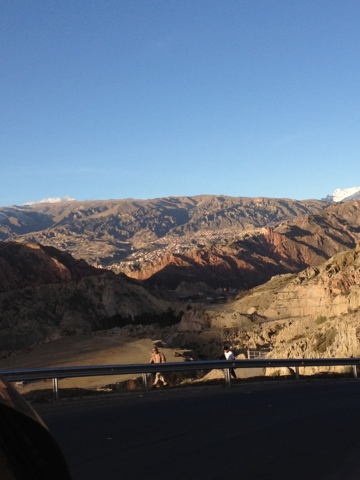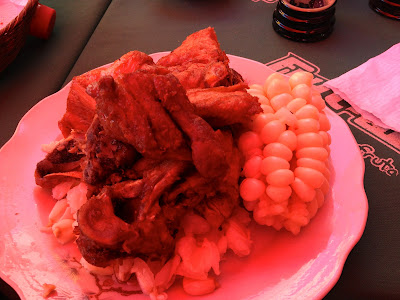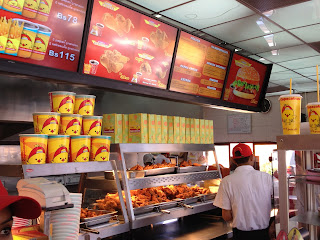The story of one traveler: Adventures from ticket purchase all the way to safe arrival home
Saturday, July 28, 2012
Thursday, July 26, 2012
Home Now- Pictures Coming
I am safely home now! Since I have stable wifi, I will be able to upload as many pictures as the blog will allow. This will be wild. Enjoy!
Tuesday, July 17, 2012
Past 3 Days
For the past 3 days I have been at my cousin's house in Mallasa. Had a great time! We rode his four wheeler up to this mountain area and rode around in the dirt. There was an amazing view. My cousin is obsessed with airplanes and Flight Simulator, so we spent a lot of time playing the game and downloading airplanes... it was a good time. As I write, we are preparing to go to a cemetery to visit some relatives, then have some ice crew, and go to a local botanical garden. Since I have limited internet, I have not been uploading that many pictures lately ( I have 150 MBs left). When I arrive home in 6 days, I will be posting my pictures like crazy, thanks to good old American wifi.
Wednesday, July 11, 2012
Day 12: Downtown Adventure
Yesterday, July 10, we ventured downtown to visit my aunt Lucy. Downtown La Paz, or "el centro" is extremely crowded. Since transportation is a private industry, there are tons of different ways to go into the city. However, the government sets all prices for bus fares. It's quite interesting.
El centro really isn't that far away, but there are SO MANY CARS and SO MANY PEOPLE that it takes about an hour to get into the city. My papito says that all Latin American cities are extremely populated and crowded. We rode a bus into the city for 1.5 Bs, about $0.22. We were lucky to get seats on the way into the city. I'll explain later.
 |
| San Francisco church |
 |
| Lechon with potatoes and plantain |
 |
| Me and mi Tia Lucy |
 |
| My mom and Mt. Illumani |
After lunch with my aunt and her sons, (my mom's cousins) Cesar and Rodrigo, we went out for more Bolivian shopping. Before we left the apartment where I'm staying in Calacoto, mi mamita told me to not say a word in English or Spanish while shopping. If the vendors suspect you are a "gringo," or white from the United States, England, or any country that they expect you to be rich, they charge you much more for a product. I didn't take mi mamita's advice and spoke Spanish, and we did find some unusually high prices here and there- like a man who followed us on the street and offered a table decoration piece of fabric (don't know how to describe it) for 500 Bs, nearly $100! It was not worth that much, so we turned down the strange offer. The good part about the vendors making up the prices as you ask is that you can haggle the prices down. That's what me and my aunt did. I would ask, in Spanish, if a price seemed
reasonable, and my Paceña aunt (meaning a native from La Paz) would say how we could find the item cheaper, proceeding to ask the vendor to lower the price. It worked almost everywhere. We make a good team!
 |
| A shop with various items on sale |
 |
| Another shop with items on sale |
The way back to the apartment was much more... stressful. From the plaza of the San Francisco church we had to catch a specific bus going back into Calacoto. There were tons of buses everywhere. Luckily our bus was right there at the plaza. We had to run to catch it. Once on the bus, we realized there were no seats, which is totally normal for a busy Latin American city. This would have been fine, except for my height so I had to duck the whole way until I could get a seat. The bus, made to seat 29, had 60 people at one point (I counted!) At one point there was a man who PAID to ride the bus, standing on the bottom step hanging out the door of the bus, having to hold on for every little bump and turn. That would never fly in the United States. I know I felt every bump and quick turn/ stop, so imagine how the man hanging out the door felt. When someone wanted to get off the bus, everyone would have to get off to let the person go, since the whole aisle was filled with people standing back to back and side to side.
We got home, safely, an hour after we left the city. It was amazing- such a great experience. I hope we can go back soon.
Sunday, July 8, 2012
Day 7: Pictures from the Mountains
Enjoying life in La Paz. Here are some pictures of the mountains. This post is short because it is being written from my iPhone from wifi. Sorry about that!
Location:
Calacoto Distrito Sur
Saturday, July 7, 2012
Internet Connection
My apologies that I haven't been able to upload the pictures from several days ago. I thought I would have wifi to upload pictures, but unfortunately I haven't been able to access a wifi hotspot. Currently, I am using a Bolivian company, Tigo, and one of their products for internet: mobile broadband. The mobile broadband is basically a USB stick that connects my computer to Tigo's 3G network. Unfortunately, I have a limit of 2000 MB. The MBs go very fast and the pictures take a really long time to upload. I promise that the next time I have wifi I will upload the pictures to the appropriate posts!
Update 7/8/12:
The pictures have been posted!
Update 7/8/12:
The pictures have been posted!
Thursday, July 5, 2012
Day 6: Fourth of July & Movie Searching
Happy Fourth of July! Sadly, in Bolivia there was not much celebrationfor this American holiday. There were, however, fireworks in the early eveningwhen the sun set. Didn’t get any pictures, but the fireworks were very nice. Ithink I even saw some Roman Candles and other fireworks that are illegal in the U.S.
Today, we went to buy some movies at local stores. Movieshere are very cheap. A DVD costs 10 Bolivianos ($1.44) and a Blu Ray costs 20Bs. ($2.87). This is what one of the stores we went to looks like. The DVDs andBlu Ray discs aren’t in such great condition, so you can ask for them to betested out. In the picture, that is why there is a TV at the store. They haveall sorts of movies, old ones and new ones alike. All though all movies havetitles in Spanish, they almost always come in English as well. Every once in awhile, a movie you test out is recorded illegally in a movie theater. Thequality is so poor that you don’t want to buy the movie. It’s pirated movieslike that, that probably explain why the costs are so low for the movies. Allof the movies I bought are good quality; although, some discs might be copies.I’ll never know.
Day 4-6: Food Compilation
In the past 3 days, we have eaten delicious Bolivian food.This post contains information from all 3 days-- pictures will be posted tomorrow 7/6/12
On July 2 (Day 4), we ate salteñas from one of the best placesin the city. Salteñas are difficult to describe, and the pictures I took don’t dothem justice. It is sweet dough that is wrapped up and curled on the top.Inside the dough is a stew. The stew contains hardboiled egg, a black olive,peas, potatoes, and the meat of your choice. You can choose whether to have a salteñade pollo or una salteña de carne (chicken salteña, or a beef salteña).They are both delicious, but they look identical from the outside. I prefer thesalteñade carne. Two salteñas make a good meal. Each salteña only costs 4.5 Bolivianos, or about$0.65.
On July 3 (Day 5), my grandparents made us this Bolivianmeal called “Ranga.” Rango is mainly composed of cow stomach, boiled with bayleaf and garlic and then sliced into thin pieces. It is then mixed with ayellow chili sauce. It is served with white potatoes, and onions and tomatoes(salsa). I don’t like the texture that the cow stomach has, so my grandma mademe an alternative Bolivian dish, “Revuelta.” Revuelta is simply scrambled eggwith beef, peas, and potatoes. I didn’t take a picture of this revuelta, but Iwill be able to take another picture of the meal later.
Today, July 4 (Day 6), my grandparents made us a Bolivian dish,“Estofado de carne.” It is basically a beef stew. Since the cows eat differentfood in Bolivia than in the United States, the meat tastes much different thanthe meat in the U.S. Strangely, the meat tastes much better here. The meat issliced into thin strips, and cooked with onions, tomatoes, onions, and atraditional chili pepper. It is served with parsley and rice. Delicious!
Monday, July 2, 2012
Day 3: Lunch and Mountains
Today we went out to eat at a local restaurant in Cota-Cota,
a part of La Paz. The restaurant serves everything from lamb to pork, to
chicken and beef. I ordered Chicharon de cerdo, a traditional Bolivian dish of
pork. It was amazing. We ordered an appetizer of patitas, pickled pork legs
with pork lunchmeat and assorted vegetables. Take a look for yourself. I only
liked the lunchmeat, I didn’t like the pork legs. My grandma ordered lamb ribs…
I didn’t try them but they looked alright. With out meal we ordered Elinga, a dark beer that contains only 3% alcohol, and some Coca-Cola, of course. I was told that the Elinga was so light that it barely tasted like beer, but it seemed pretty strong to me! In Bolivia there are no real laws about underage drinking, so there is no issue with minors drinking, unless you’re 11 or 12 years old or something like that.
I didn’t try them but they looked alright. With out meal we ordered Elinga, a dark beer that contains only 3% alcohol, and some Coca-Cola, of course. I was told that the Elinga was so light that it barely tasted like beer, but it seemed pretty strong to me! In Bolivia there are no real laws about underage drinking, so there is no issue with minors drinking, unless you’re 11 or 12 years old or something like that.
Day 2: Day on the Town- The Traditional Market
The traditional supermarket where you buy all of your groceries
doesn’t apply in Bolivia, unless you want to pay premium prices for the same
products. My grandparents aren’t, so Saturday morning we ventured out to one of
the many markets in the city. Called, “El Mercado,” this traditional method of
buying vegetables, fruits, and meats is quite fascinating. While I have seen
markets like these on TV, seeing them in person is such a unique experience
where I have to find myself constantly ducking to avoid hitting my head on the
exposed nails and electrical wires holding up the roof of the large room/ shack
where El Mercado is. The first picture I took of El Mercado features mi papito
signaling my mamita to come see specific fruits. As you can see in the
background, there are all sorts of vendors along a narrow dirt path. After a
couple of vendors, you find a big open shack/ room where natives come to sell
their fruits and vegetables they have acquired from Las Yungas, or a nearby
tropical area where fruits and vegetables are able to grow. None of the fruits
and vegetables you buy at the market are farmed commercially, and you can tell.
These fruits and veges are bruised and have all sorts of marks on them.
However, these fruits and vegetables are organic and ripen naturally- and you
can taste that! The tropic zone, Las Yungas, is so perfect for farming that the
fruits and vegetables come out HUGE in size. From the pictures I am posting
here, you can see that there are all sorts of vegetables, some that we are
familiar with, and some not so much. I found myself asking my mom and mis
papitos many times what certain fruits/ vegetables are. A couple vendors
allowed us to take pictures of them selling their products, so they are also
posted here. The contents of this bag shown only cost $7 American dollars, or
about 50 Bolivianos.
Mis papitos visit the same vendors every time they go
grocery shopping. That way, the people you get to know give you discounts and
are nicer to you. Even if you can’t get a discount, you can be sure you aren’t
getting ripped off if you see the same vendors.
Milk is also consumed differently. Milk is sold in bags and
not cartons. It is quite interesting! You cannot buy a carton, because they
aren’t sold anywhere. They have all sorts of sizes of bags, and you can buy a
variety of flavors of milk. We bough a couple bags of “Leche de Frutilla” or
strawberry milk. If you would like to drink it without a cup, which you very
well can and many do, you simply nibble off a corner of the bag and drink from
the bag. It’s actually more fun than drinking from a glass, and the milk is
healthier. You can also buy soy milk this way.
Groceries are a unique aspect of Bolivia, whether you buy
them at an American style grocery store, or en el mercado.
 |
| My grandpa signaling my grandma |
Location:
Nataniel Aguirre 927, La Paz, Bolivia
Day 2: Day on the Town- The American Style Grocery Store
Even though I am thousands of miles away from the US, I can
still find great fast food, American movies in Spanish, and American cereal! All
of these great products, of course, can be purchased at the local, American
style grocery store. These sorts of grocery stores contain dry products, such
as chips, cereal, tissues, soaps, as well as vegetables and fruits. But fruits
and vegetables can be purchased at the local market, “El Mercado,” for much
cheaper. That’s enough to fill a different post… and it will!
Similar to KFC, I can eat delicious fried chicken at Pollos
Copacabana. I think that the chicken at Pollos Copacabana is a lot better than
KFC, but I guess you will have to try it for yourself! I ordered 2 legs and a
breast- a combo meal, which comes with a soda, fries, and optional, fried
plantains. The combo meal is served with Bolivia’s famous llajua (pronounced
yaaa-huaaaa), similar to a salsa, and the restaurants signature sauce, which I
believe contains ketchup, mustard, and a bit of mayo, but no one really knows. In
Bolivia you can also find a Burger King, and Subway. You cannot, however, find
any McDonalds fast food restaurants. The chain came to Bolivia many years ago
and was put out of business by Burger King… interesting, right?
At the Mega Center, or a local shopping complex/ mall, I can see “Los Juegos del Hambre” – The Hunger Games, “Valiente”- Brave, or even “Hombre-Arana”- Spiderman. Almost all of the movies are shown in Spanish, with a few exceptions that only have Spanish subtitles. This is a huge change from seeing movies 5 years ago, where all movies were shown in English with Spanish subtitles.
If you head over to a local grocery store, you can find almost all American cereals—if you’re willing to pay for it. Sure, you can find Honey Nut Chereos imported from the United States, but you have to be willing to pay 124.50 Bolivianos, or $17.94. If you aren’t willing to pay such a steep price, you can settle for Chockgol (a chocolate cereal themed after Latin America’s precious soccer), or Choco Krispis (chocolate Rice Krispies), or you could settle for a familiar Froot Loops (packaged and sold from a Latin American neighbor) without such a steep price.
At the grocery store you can also find some great beverages.
Coca-Cola products, from Coca-Cola, Sprite, and Fanta, are manufactured,
bottled, and sold in Bolivia so they are not as expensive as an imported
beverage, but they also have a slightly different taste. Made with real sugar
and not high fructose corn syrup, the Coca-Cola from Bolivia tastes much more
real, with a better flavor. If you would like some Red Bull, the imported energy
drink only costs 12.90 Bolivianos, or $1.86—not such a bad price.
If you like hot sauce, Louisiana Hot Sauce only costs 6
Bolivianos to 15 Bolivianos (depending on bottle size), or $0.86 to $2.16—a
steal. But, this familiar hot sauce is not manufactured in the US, but at a
facility near Bolivia.
It’s always nice to find American products when in a foreign
country, but sometimes you have to be willing to pay for imported products.
Sometimes, though, you can settle for the same brand manufactured somewhere
closer to Bolivia for a cheaper price.
Subscribe to:
Comments (Atom)


















































